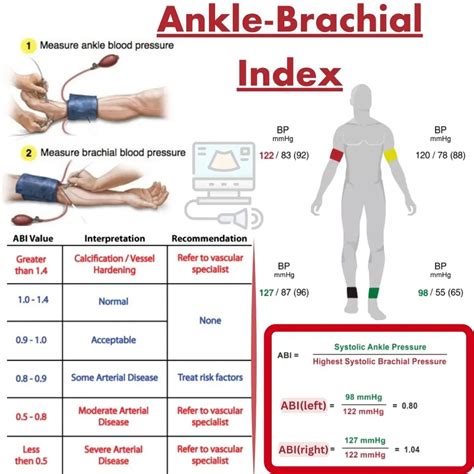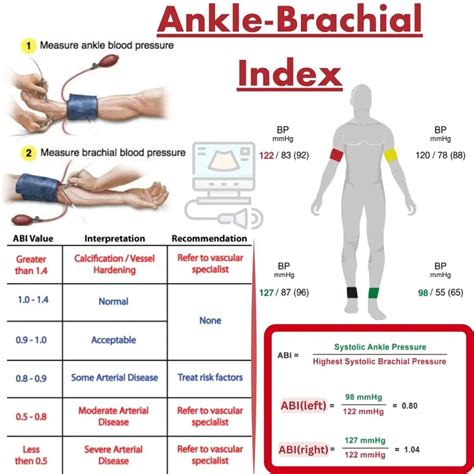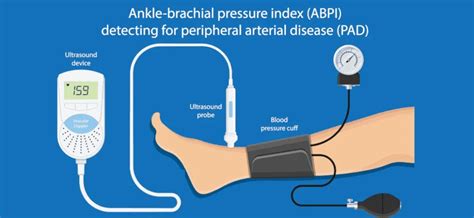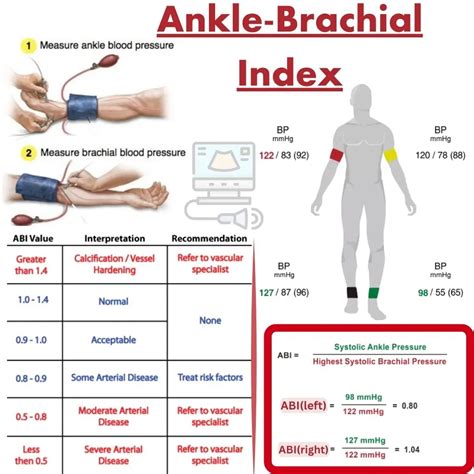Intro
Learn about the Ankle Brachial Index (ABI) test, a non-invasive diagnostic tool for peripheral artery disease (PAD), using blood pressure measurements and ratios to detect vascular diseases and circulatory issues.
The Ankle Brachial Index (ABI) test is a non-invasive and painless medical procedure used to diagnose peripheral artery disease (PAD). It is a simple yet effective way to assess the blood flow to the legs, helping doctors to identify any potential blockages or narrowing of the arteries. The ABI test is widely used in medical settings, and its results can have a significant impact on a patient's treatment plan and overall health. In this article, we will delve into the world of ABI testing, exploring its importance, benefits, and what to expect during the procedure.
The ABI test is a crucial diagnostic tool for detecting PAD, a condition that affects millions of people worldwide. PAD occurs when the arteries in the legs become narrowed or blocked, reducing blood flow to the muscles and tissues. If left untreated, PAD can lead to severe complications, including leg pain, gangrene, and even amputation. The ABI test helps doctors to identify PAD in its early stages, allowing for prompt treatment and reducing the risk of complications. By understanding the importance of the ABI test, patients can take a proactive approach to their health, seeking medical attention if they experience any symptoms of PAD.
The ABI test is a relatively quick and straightforward procedure, typically taking around 30 minutes to complete. During the test, a healthcare professional will use a Doppler ultrasound device to measure the blood pressure in the arms and legs. The results are then used to calculate the ABI, which is a ratio of the blood pressure in the ankles to the blood pressure in the arms. An ABI of 1.0 to 1.4 is considered normal, while a lower ratio may indicate PAD. The test is usually performed in a doctor's office or clinic, and patients do not require any special preparation or fasting beforehand.
What is the Ankle Brachial Index Test?

How is the Ankle Brachial Index Test Performed?
The ABI test is typically performed in a doctor's office or clinic, and the procedure involves the following steps: * The patient is asked to lie down on an examination table or sit comfortably in a chair. * A healthcare professional will use a Doppler ultrasound device to measure the blood pressure in the arms and legs. * The blood pressure is usually measured at the brachial artery in the arm and the dorsalis pedis artery in the foot. * The results are then used to calculate the ABI, which is a ratio of the blood pressure in the ankles to the blood pressure in the arms. * The ABI is calculated by dividing the systolic blood pressure in the ankles by the systolic blood pressure in the arms.Benefits of the Ankle Brachial Index Test

What do the Results of the Ankle Brachial Index Test Mean?
The results of the ABI test are used to diagnose PAD and other circulatory problems. The results are interpreted as follows: * ABI of 1.0 to 1.4: Normal * ABI of 0.9 to 0.99: Borderline * ABI of 0.4 to 0.89: Mild PAD * ABI of 0.1 to 0.39: Moderate PAD * ABI of less than 0.1: Severe PADWho Should Have an Ankle Brachial Index Test?

What to Expect During the Ankle Brachial Index Test
During the ABI test, patients can expect the following: * A healthcare professional will explain the procedure and answer any questions. * The patient will be asked to lie down on an examination table or sit comfortably in a chair. * The healthcare professional will use a Doppler ultrasound device to measure the blood pressure in the arms and legs. * The test is relatively quick, typically taking around 30 minutes to complete. * The results will be used to diagnose PAD and other circulatory problems.Risks and Complications of the Ankle Brachial Index Test

Preparing for the Ankle Brachial Index Test
To prepare for the ABI test, patients should: * Wear loose and comfortable clothing * Avoid smoking or consuming caffeine for at least 30 minutes before the test * Avoid eating a heavy meal before the test * Inform the healthcare professional of any medical conditions or medicationsFollow-Up Care After the Ankle Brachial Index Test

Conclusion and Next Steps
The Ankle Brachial Index test is a valuable diagnostic tool for detecting PAD and other circulatory problems. By understanding the importance of the ABI test and what to expect during the procedure, patients can take a proactive approach to their health and seek medical attention if they experience any symptoms of PAD. If you are at risk of developing PAD or have concerns about your circulatory health, consult with your doctor about undergoing an ABI test.What is the purpose of the Ankle Brachial Index test?
+The purpose of the Ankle Brachial Index test is to diagnose peripheral artery disease (PAD) and other circulatory problems by measuring the blood flow to the legs.
Who should have an Ankle Brachial Index test?
+Individuals over the age of 50, smokers, individuals with a family history of PAD or other circulatory problems, individuals with high blood pressure or high cholesterol, and individuals with diabetes should have an Ankle Brachial Index test.
What are the benefits of the Ankle Brachial Index test?
+The benefits of the Ankle Brachial Index test include non-invasive and painless, quick and easy, accurate results, and cost-effective.
We hope this article has provided you with a comprehensive understanding of the Ankle Brachial Index test and its importance in diagnosing peripheral artery disease. If you have any further questions or concerns, please do not hesitate to reach out to your healthcare professional. Share this article with your friends and family to raise awareness about the importance of circulatory health, and take the first step towards a healthier you.
